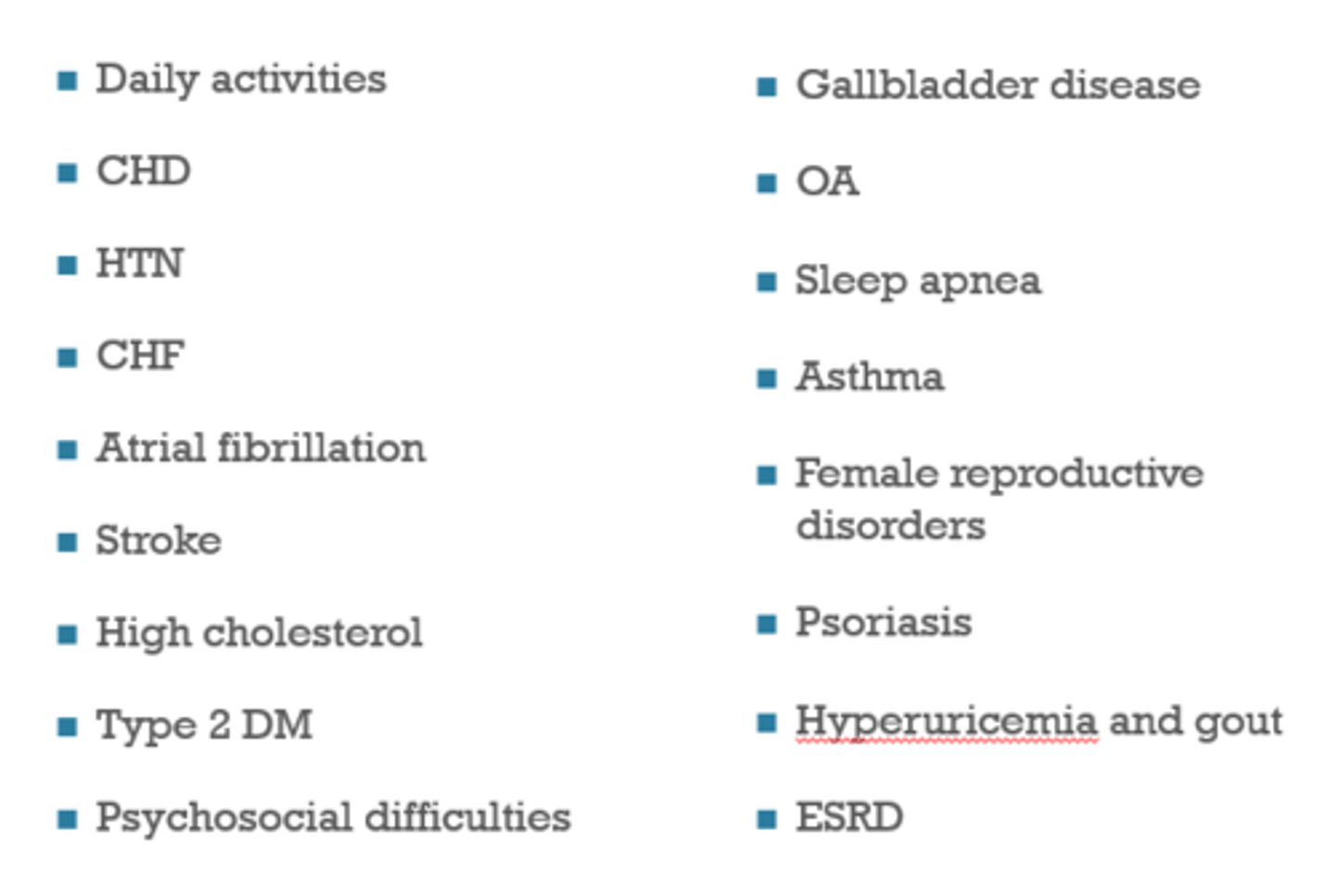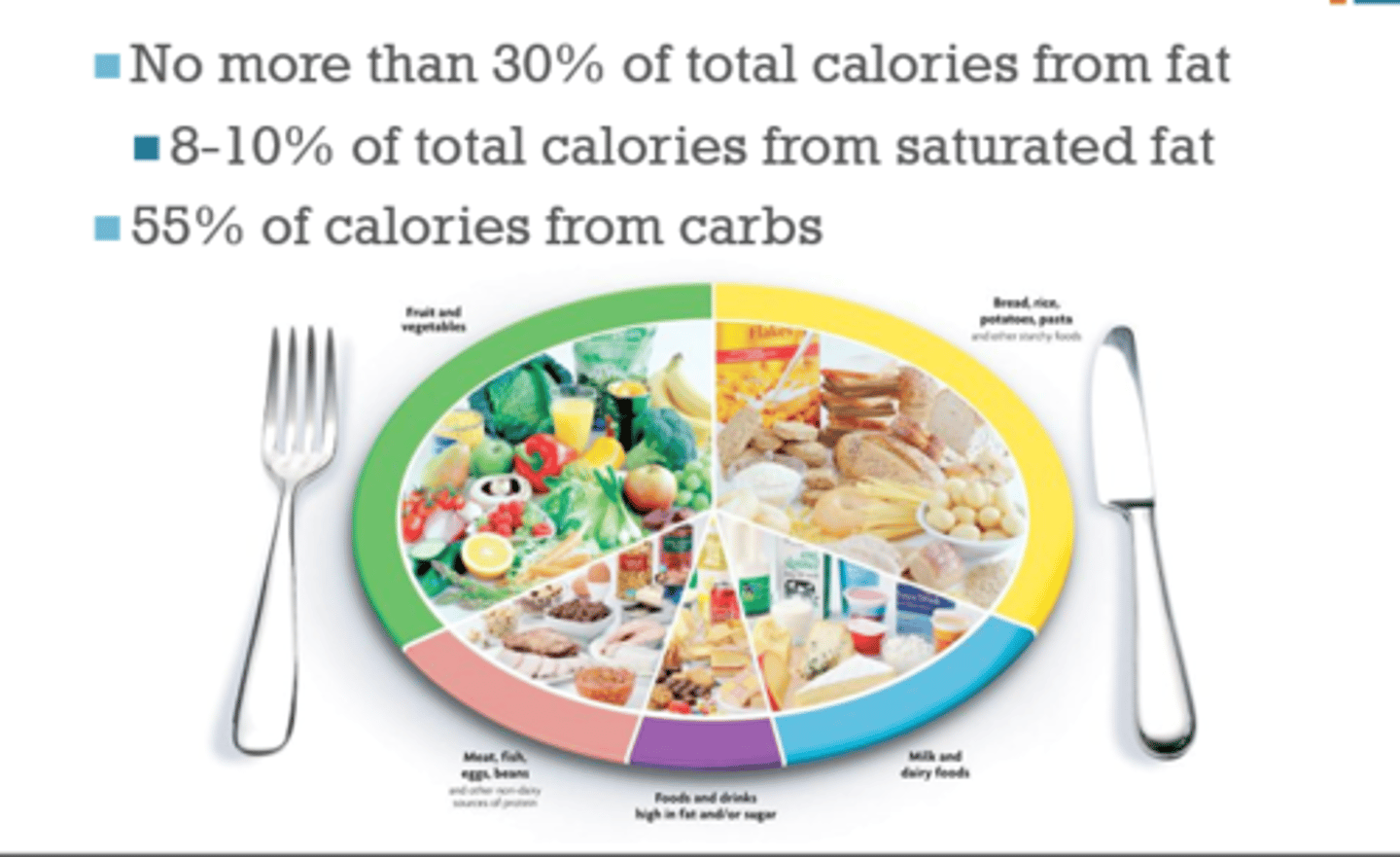overweight and obesity
1/44
There's no tags or description
Looks like no tags are added yet.
Name | Mastery | Learn | Test | Matching | Spaced |
|---|
No study sessions yet.
45 Terms
Weight gain =
energy intake > energy expenditure
1lb of adipose tissue =
3500 calories
genetic factors that affect weight:
- people who enjoy sugar and carbs
- balance of hormones and proteins
BMI =
weight (kg) / height squared (m^2)
or
lb/in^2 x 703
BMI may underestimate risk in what population?
in Asian and South Asian population
higher BMI is a risk factor for some diseases such as?
CVD, HTN, T2D, gallstones, breathing problems, and certain cancers
classification of BMI

BMI percentile in pediatrics and adolescents:
85th-95th percentile = overweight
>95 = obese
what is the waist circumference for both men and women that is associated with increased risk of T2DM and CVD?
>40 in men
>35 in women
What are some characteristics of metabolic syndrome? (need 3 or more of these to be diagnosed)
- HDL is less than 40mg/dL in men or less than 50 mg/dL in women
- BP level of 130/85 or higher
- the waist circumference measurement
- serum triglycerides of 150 mg/Dl or greater
- fasting serum glucose of 100 mg/dL
complications of being overweight/obese:

what are some pharmacotherapy management for weight loss?
- OTC agents and prescription agents
weight loss surgery includes:
gastric bypass and lap band
what is the initial goal of weight loss?
- reduce body weight by 5-10% over 6 months
- benefit of first 10% loss
what is the mainstay of weight loss therapy?
dietary modification
please refer to slides 20-22 for BEE expenditure stuff
tehe
low calorie diet (LCD):
800-1500 kcal/day
weight loss =1-2 pounds/week
very low calorie diet (VLCD):
- 800 or fewer calories
- patients with BMI>30 should at least contain 1g/kg of IBW of protein/day
- expected weight loss but comes with ADE
altered proportions of food groups:
this visual goes hard

meal replacement therapy:
Replace two meals daily with liquid drink, snack bar, or measured frozen meal
Eat "reasonable" third meal
Main advantage: portion control
Initial weight loss due to low sodium
how much physical activity is recommended for children and adolescents?
>60 mins of moderate or vigorous aerobic activity every day, including vigorous activity at least 3 days a week
how much physical activity is recommended for adults?
- 150 minutes of moderate aerobic activity or 75 minutes of vigorous physical activity a week
- Initially performed in ≥10 minute episodes
dietary products include herbals and other supplements regulated under DSHEA, and are recognized as SAFE unless
FDA says otherwise
OTC Orlistat (Alli) MOA
decreases absorption of dietary fats by inhibiting gastric and pancreatic lipases and inhibits hydrolysis of triglycerides
OTC Orlistat dosing:
60 mg TID before meals containing fat
Rx strength Orlistat dosing:
120 mg TID before meals
Orlistat may decrease absorption of what? and what is recommended?
- fat soluble vitamins
- MVI QD at bedtime or separated by at least 2 hours from Orlistat
Orlistat ADE
- increased levels of urinary oxalate
- flatulence with oily spotting
- loose and frequent stools
- fatty stools
- fecal urgency/incontinence
Orlistat drug interactions:
- Warfarin
- Cyclosporin - reduces concentration
Orlistat should be avoided in patients with?
malabsorption disorders
Who should consult MD before starting Orlistat?
those with HX of thyroid disease, cholelithiasis, nephrolithiasis, or pancreatitis
Patients should stop use of Orlistat and contact physician if there are signs and symptoms of?
liver injury, itching, yellow eyes or skin, dark urine, light colored stools, or loss of appetite
what meds are inappropriate for weight loss?
laxatives and diuretics
herbal supplements include stimulants, energy boosters, and thermogenic acids that claim to increase what?
basal metabolism, increases energy, and counteract fatigue
what is a common ingredient in herbal supplements?
Bitter orange
used in many reformulated products after ephedra ban
what are the active ingredients in bitter orange?
synephrine- similar to ephedrine
octopamine- similar to NE
have same risks to NE (HTN, CV toxicity, MI)
Bitter orange is often combined with?
caffeine
examples of fat and carb modulators:
- green tea
- chromium
- garcinia
large doses of chromium results in
rhabdomyolysis and renal failure
also increases insulin sensitivity
limited evidence of benefit
What are some risks associated with OTC weight loss products (stimulants such as caffeine)?
GI distress, nausea, dehydration, headaches, insomnia, nervousness, anxiety, heart, palpitations, increase in blood pressure, vertigo
OTC weight loss agents such as stimulants, energy boosters, and thermogenic agents such as caffeine should be used in caution with patients who have?
renal disease, panic disorder, hyperthyroidism, anxiety or spasms
Risks associated with appetite suppressants and promoters (glucomannan, guar gum, hoodia, plantain or psyllium):
flatulence, GI distress, nausea, vomiting
hoodia has no recent risks reported
laxatives and diuretics risks (cascara sagrada and dandelion):
ab pain, cramps, diarrhea, chronic use can lead to potassium depletion, disturbed heart function, muscle weakness
dandelion should be avoided in patients with
gallbladder or bile duct obstruction
are there any contraindications with Orlistat?
no, but monitor for side effects and counsel side effects and overall weight loss